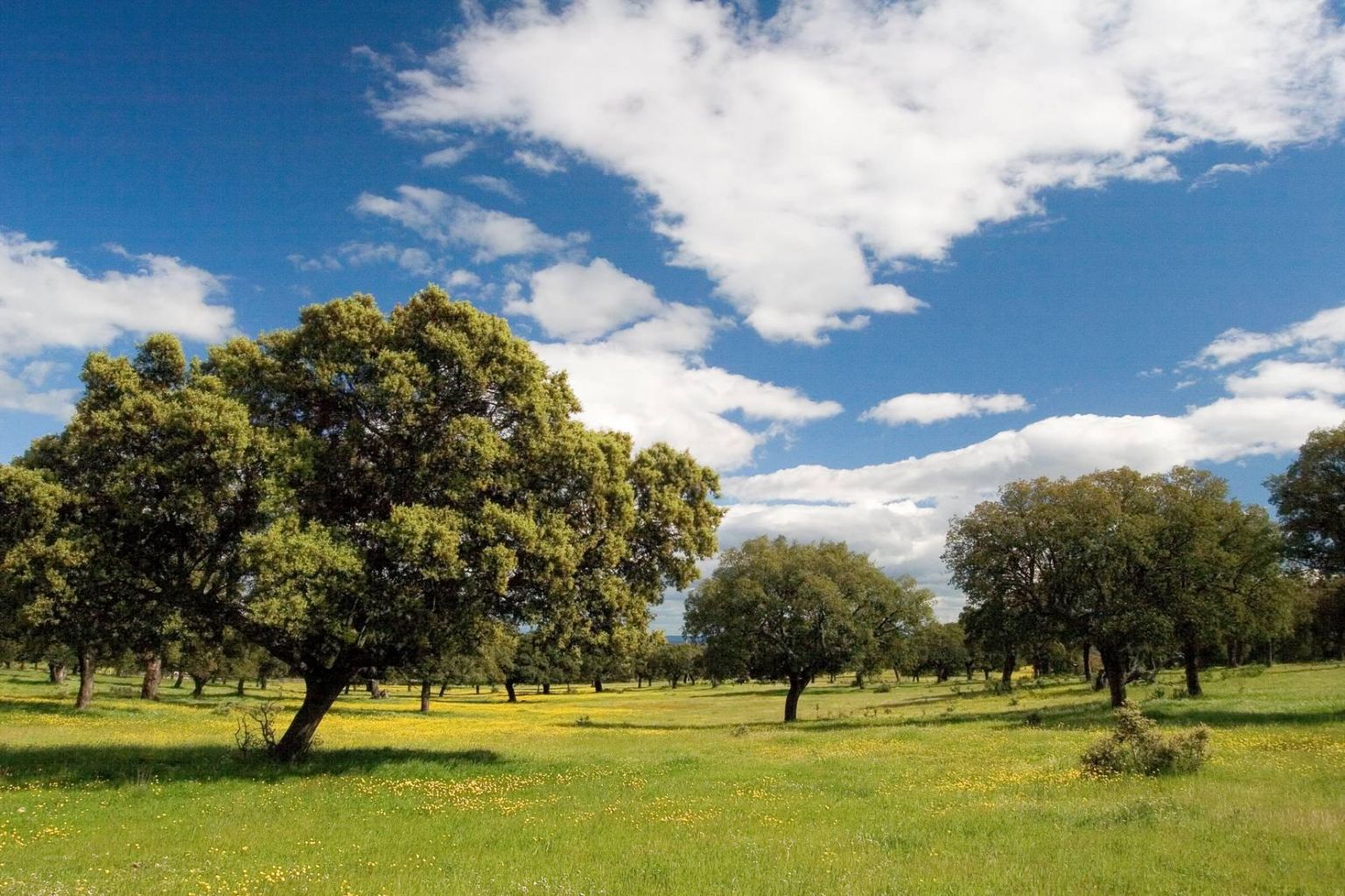
Dehesas em Espanha
Descrição do sistema
A Dehesa é um sistema agrosilvopastoril formado a partir do desmatamento de florestas onde as árvores, gramíneas nativas, culturas e gado interagem positivamente sob gestão. Actualmente as dehesas ocupam 2,3 milhões de hectares em Espanha e 0,7 milhões de hectares em Portugal, onde são chamados de Montados. As Dehesas resultam de uma simplificação, na estrutura e na riqueza de espécies, das florestas e matagais mediterrânicos, e são alcançados através da redução da densidade de plantação, da eliminação do coberto arbustivo e favorecendo o coberto herbáceo por intermédio de pastagens e culturas.
As Dehesas caracterizam-se pela criação de raças de gado tradicionais em baixas densidades e exploração cuidadosa de azinheiras e sobreiros. Os Montados estão entre os sistemas agrícolas de baixa intensidade melhor preservados da Europa e neles a integração da utilização das terras tradicional e a conservação da biodiversidade é considerada uma gestão do uso da terra exemplar.
Reunião de stakeholders inicial
A primeira reunião de stakeholders realizou-se a 30 de Maio de 2014, na Escola de Silvicultura da Universidade da Extremadura em Plasencia (Cáceres, Espanha). Estiveram presentes mais de 90 stakeholders. Entre os participantes encontravam-se agricultores, criadores e gado, silvicultores, proprietários rurais, representantes das associações regionais e nacionais, empresas de serviços agrícolas, serviços de extensão, ONGs relacionadas com a natureza, grupos de acção local e decisores políticos.
Uma análise abrangente da percepção dos aspectos positivos e negativos do sistema dehesa e inovações potenciais para investigação foi realizada. Entre as áreas potenciais identificadas para pesquisa encontram-se os métodos de regeneração da árvore, culturas forrageiras, pastagens e a possibilidade de uma marca "Dehesa".
Se quiser saber mais sobre a actividade deste grupo, por favor, entre em contato com o Dr. Gerardo Moreno da Universidade da Extremadura.
Faça download do relatório inicial de stakeholders
Faça download do protocolo inicial de pesquisa e desenvolvimento
Download the system description
A research update on dehesas in Spain was produced in December 2015.
Lessons learnt
Gerardo Moreno and colleagues at the University of Extremadura have written a comprehensive and informative report on the various innovations tested within the Dehesa stakeholder group in Spain.
The first part of the report focus on the search of alternative low cost shelters and practices for the regeneration of the trees of the dehesa. Some of the main lessons learnt are:
- Tree regeneration in the dehesa needs to be an integrated part of regular management practice; a rotational stage of grazing exclusion could be included in long-term farm management plans.
- Assisted regeneration can be based either on seeding acorns or on planting nursery-grown seedlings. Both approaches require seed and/or seedling protection.
- Application of cat/dog excrement around sown acorns can be recommended for small scale reforestation. CHANGE around young plants BY acorns sown
- Thorny wire-mesh tree guards proved to be an efficient, long-lasting solution and cheaper form of tree protection than classic wire mesh tree guards.
The second part of the report focuses on the option to improve fodder self-sufficiency by using protein-rich fodder crops and self-seeding pastures. Some of the main lessons learnt are:
- Three varieties of triticale are recommended; the trees can increase winter forage yields and the quality of the forage. The triticale can be grazed by livestock in the winter before the start of stem elongation.
- The sowing of legume-rich self-reseeding pasture can increase pasture productivity and quality for at least a decade. Grazing needs to be delayed in the initial years to ensure good establishment.
- The increase in the soil nitrogen, due to the legumes, also increases the protein content of other pasture species.
- The sowing of pasture increased the soil content of carbon accumulated. Although it reduced slightly the α diversity of plants, the total species richness (ϒ diversity) was unaltered.
- Farmers in the study reported that the improvement in the pasture quality and productivity offset the costs of the seed mixture and fertilizers.
The third part of the report focused on consumer acceptance for dehesa products and services. Some of the lessons learnt are:
- Consumers were more familiar with the term "dehesa" than "agroforestry"
- Consumers associated the dehesa with high-quality livestock products and a landscape of high cultural value.
- Possible dehesa products with development potential include asparagus, fungi and mushrooms, acorn-based foods, medicinal plants and cosmetics, herbs and herbal tea. CHANGE acorn beer BY acorn-based foods
Lastly the report highlights that more research is still needed on the use of new technologies (such as GPS collars) to improve dehesa management and the use of fast-intensive rotational management. Preliminary results also indicate that (ignoring the methane produced by livestock), a positive annual carbon balance of the dehesa of Majadas of about 0.5 t C/ha.